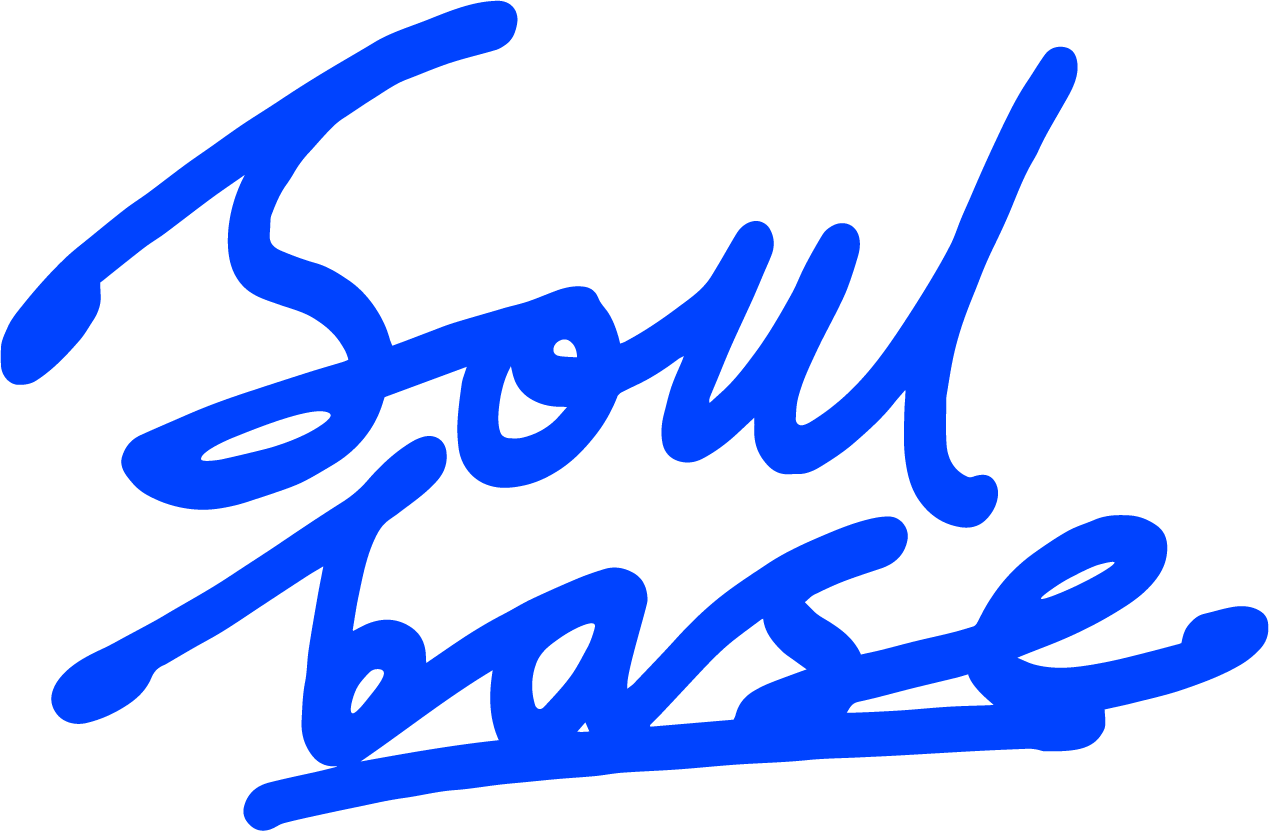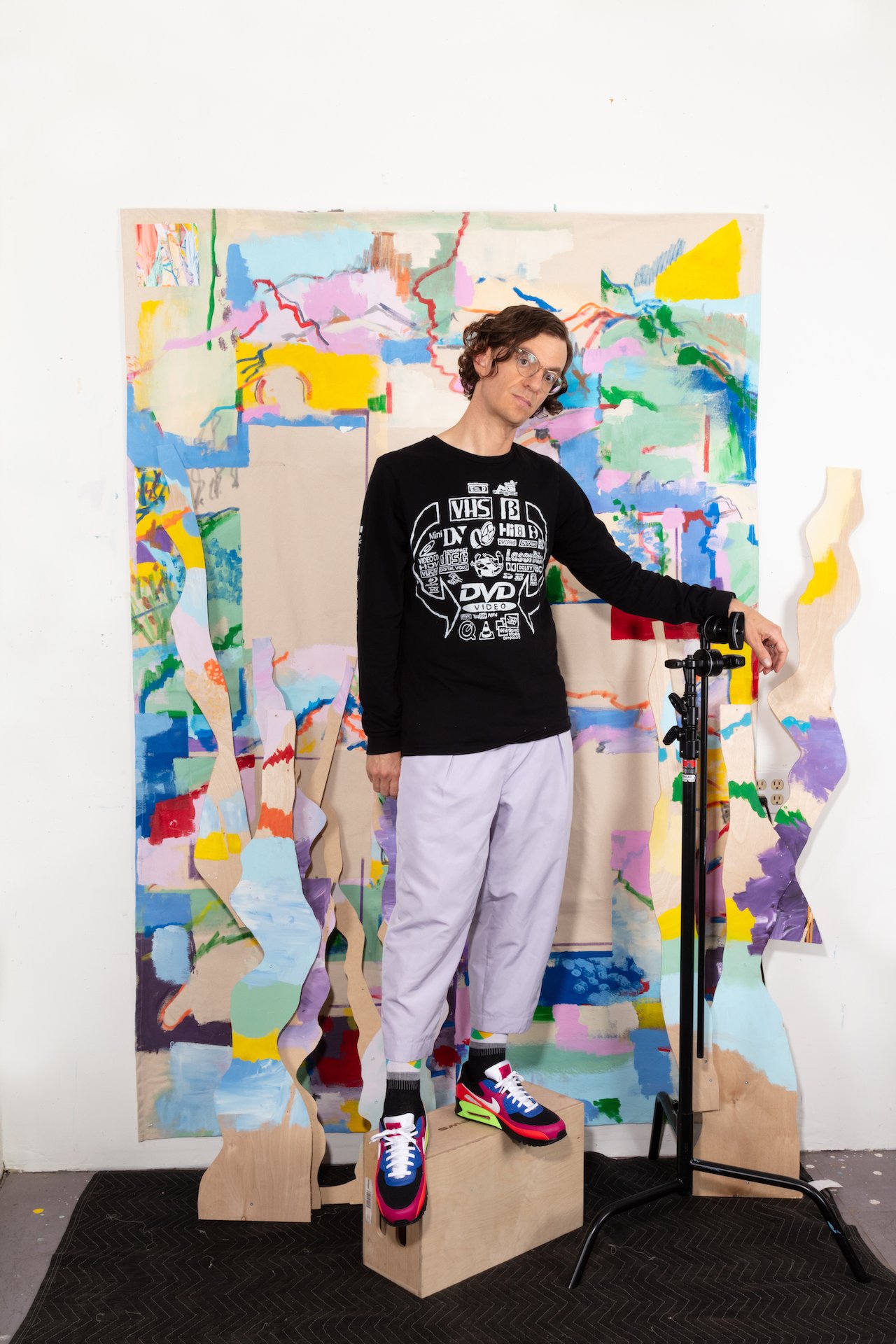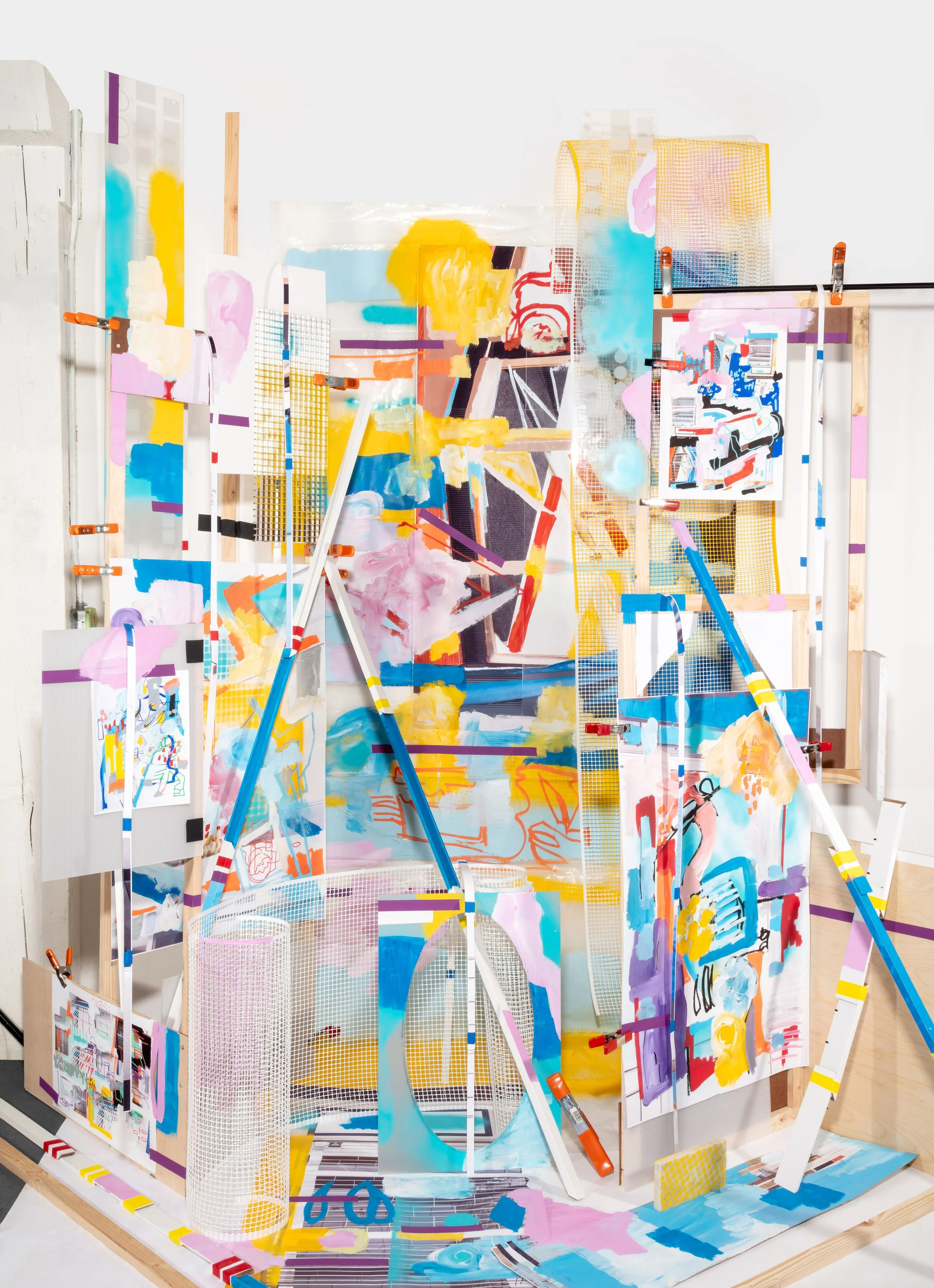Chris Lael Larson :
Blurring Boundaries Between Art and Life—A Journey from Earth Sciences to Unconventional Masterpieces That Challenge and Inspire."
Chris Lael Larson’s journey to becoming a visual artist is as unconventional as it is inspiring. From his early days studying Earth Sciences to exploring the intersection of music and visual art, Larson's evolution reflects a deep connection with both the natural world and the absurdities of modern life. His current work blurs the boundaries between photography, painting and assemblage, with each piece inviting viewers to engage with the everyday absurd through a blend of humor, terror and beauty. Balancing his artistic practice with a full-time career as a graphic designer, Larson continues to push creative boundaries, exploring the latent qualities of materials and reframing their meanings in ways that challenge and inspire. His works have been featured in notable exhibitions, from the Berkeley Museum of Art to the Portland Institute of Contemporary Art, where his artistic voice continues to evolve and resonate.We sat down with Chris to learn more about his unique style, his artistic process and his perspective on creativity, success and how art reflects life.
Imagery & Styling by: Chris Lael Larson
Can you tell us about your artistic journey? How did you evolve from your early days in Earth Sciences to becoming a visual artist?
My journey has been varied and circuitous. While I studied Earth Sciences at university and had a lifelong love of the natural world, I realized that I wasn't interested in pursuing it with any rigor outside of school. Instead, following school, I focused on combining music and video art for several years—finding ways to blend synched, experimental, projected visuals with live, rhythm-focused, instrumental music. I have always made music and visual art. This was a way to combine both into a single practice, creating an experience that blurred the lines between an experimental film screening and a bombastic, double drum set dance party. Natural elements were a through-line, both thematically and visually, with the art I created during this time.
After performing, touring and releasing music for several years, I was ready for a new focus that required less physicality, logistics and late hours. The combination of travel, booking, promotion and live AV production—on top of writing/recording music and creating videos—became too taxing to continue sustainably. Around this time, I was living in a warehouse, and a studio space opened up where I could expand my photography practice. I took this opportunity and shifted my attention to visual art, starting with a focus on photography. I spent a few years experimenting and developing my craft and voice. It took a while, and I explored a lot of different approaches.
It wasn't until the pandemic, when I could not access my photo studio due to COVID-19 precautions, that I started painting and drawing at home. I was also dealing with health issues, so mark-making became a therapeutic practice for me. Following the pandemic, when I could reaccess my studio, I started combining my burgeoning painting practice with my photographic practice, which led to the work I am creating now.
Is your current art your full-time job or do you have multiple creative outlets?
I'm not a full-time artist, but many people I meet assume that I am. I work a full-time job as a graphic designer to support my practice at this time. I am trying not to prematurely burden my art practice with financial support. It is essential for me at this phase to give my practice the space it needs to fully actualize outside of the influence of market forces.
Your work often explores the “everyday absurd.” Could you elaborate on what this concept means to you and how it shapes your creative process?
Even long before modernity, so much of the artificial world was absurd. Technology, pop culture, politics, the economy, government: there are so many facets that we as a species have normalized that are wildly absurd. There is a humor in it, but there is also, at times, a terror. It sometimes feels overwhelming how many systems or norms are completely maladaptive and nonsensical that I almost cannot avoid it in my work. Engaging with it creatively helps me cope with it. Work that has the absurd in it resonates with me most deeply and feels weirdly "true" because the world, in large part, can feel so absurd.
Your work blurs the boundaries between photography, painting and assemblage. What do you find most compelling about working at this intersection, and how do you see it evolving in your future projects?
I like work that creates novel viewing experiences to explore ideas—formal approaches that can be enticing, disorienting or challenging. I've always been drawn to this sort of blurring between classifications. Even when I was blending live music and experimental video, we performed as often in art and film venues as we did electronic and rock venues. And I enjoyed how, regardless of the venue, the work was different than expected in each context.
On a purely formal level, I have a deep fascination with how things look when photographed—how lensing and lighting combine to create a uniquely photographic style of representation. I also love the tactility and visual language of painting and the materiality of working with found objects. In that way, I am trying to create a hybrid form that takes all the elements I am drawn to from different mediums and creates a new visual communication.
How does your experience in music, advertising and plastic arts influence your current work, particularly in terms of layering abstracted brand designs and faux iconography?
Art often reaches its most authentic and truest form when it fully reflects the unique experiences, insights and facets of the person creating it. I don't think about actively incorporating all of my facets into my work but instead focus on leaving the door open for all of them—never holding on too tightly to any notion of what particular form it should take or what components will come together to create it.
Can you describe your process of creating temporary altar-like assemblages? What steps do you take from conceptualization to the final hyperreal photographic image?
From my foundation in photography, I always begin with large-scale imagery—sometimes my imagery and sometimes things I've found or collected (e.g., discarded student paintings, outtakes from photo shoots). From there, I generally have a collection of objects or materials that relate to or build off the original images' theme or formal qualities. From there is an intuitive compositional process where I'm fluidly shifting between altering or integrating objects, painting and photographing as I create the piece. I build, paint and assemble the images iteratively, creating dozens of photos along the way until landing on the final version. I will also adjust the studio lighting to bring out certain facets of the composition or refine the shape and definition of the shadows, obscuring some elements and accentuating others.
Could you discuss some of your notable exhibitions, such as those at the Berkeley Museum of Art or the Portland Institute of Contemporary Art? How have these experiences impacted your career and artistic development?
I think of every chance to share my work publicly as an experiment. They are opportunities to share a snapshot of where I am in my evolution as an artist and learn about my work through seeing it and understanding it anew through others. In this way, showing work, especially in early shows, is invaluable in developing the work.
Regardless of the show, the work and its ideas come first, guiding how the work will be shown. Once you have a venue for the work, that space becomes a new element of the work that you integrate in the same way you might incorporate new color or visual elements. The context where you present the work is part of the work.
What role do art galleries, exhibitions and online platforms play in sustaining your career as a full-time artist?
Each platform offers a different context for people to connect with the ideas in your work. All of them work together to create an ecosystem of experience with many different ways to engage. I enjoy having a range of contexts to share work in—galleries for tactile, immersive community experiences and digital platforms for small, bite-sized moments or ideas.
Your work blurs the boundaries between photography, painting and assemblage. What do you find most compelling about working at this intersection, and how do you see it evolving in your future projects?
I like work that creates novel viewing experiences to explore ideas—formal approaches that can be enticing, disorienting or challenging. I've always been drawn to this sort of blurring between classifications. Even when I was blending live music and experimental video, we performed as often in art and film venues as we did electronic and rock venues. And I enjoyed how, regardless of the venue, the work was different than expected in each context.
On a purely formal level, I have a deep fascination with how things look when photographed—how lensing and lighting combine to create a uniquely photographic style of representation. I also love the tactility and visual language of painting and the materiality of working with found objects. In that way, I am trying to create a hybrid form that takes all the elements I am drawn to from different mediums and creates a new visual communication.
How does your experience in music, advertising and plastic arts influence your current work, particularly in terms of layering abstracted brand designs and faux iconography?
Art often reaches its most authentic and truest form when it fully reflects the unique experiences, insights and facets of the person creating it. I don't think about actively incorporating all of my facets into my work but instead focus on leaving the door open for all of them—never holding on too tightly to any notion of what particular form it should take or what components will come together to create it.
Can you describe your process of creating temporary altar-like assemblages? What steps do you take from conceptualization to the final hyperreal photographic image?
From my foundation in photography, I always begin with large-scale imagery—sometimes my imagery and sometimes things I've found or collected (e.g., discarded student paintings, outtakes from photo shoots). From there, I generally have a collection of objects or materials that relate to or build off the original images' theme or formal qualities. From there is an intuitive compositional process where I'm fluidly shifting between altering or integrating objects, painting and photographing as I create the piece. I build, paint and assemble the images iteratively, creating dozens of photos along the way until landing on the final version. I will also adjust the studio lighting to bring out certain facets of the composition or refine the shape and definition of the shadows, obscuring some elements and accentuating others.
Could you discuss some of your notable exhibitions, such as those at the Berkeley Museum of Art or the Portland Institute of Contemporary Art? How have these experiences impacted your career and artistic development?
I think of every chance to share my work publicly as an experiment. They are opportunities to share a snapshot of where I am in my evolution as an artist and learn about my work through seeing it and understanding it anew through others. In this way, showing work, especially in early shows, is invaluable in developing the work.
Regardless of the show, the work and its ideas come first, guiding how the work will be shown. Once you have a venue for the work, that space becomes a new element of the work that you integrate in the same way you might incorporate new color or visual elements. The context where you present the work is part of the work.
What role do art galleries, exhibitions and online platforms play in sustaining your career as a full-time artist?
Each platform offers a different context for people to connect with the ideas in your work. All of them work together to create an ecosystem of experience with many different ways to engage. I enjoy having a range of contexts to share work in—galleries for tactile, immersive community experiences and digital platforms for small, bite-sized moments or ideas.
Your recent series "Painting Over Photos of the Mall" has garnered attention. What was the inspiration behind this series, and what message are you hoping to convey through it?
The inspiration was a group of artists and non-traditional vendors experimenting with ways to breathe new life into a massive, hollowed-out shopping mall. It was a morbid fascination, and I hate spending time in the malls and what they represent in the longer history of American consumerism. So, it was somewhat of a challenge to immerse myself in this context and create work from it, taking something that was dying and finding embers that I could bring back to life in some capacity.
I'm less interested in trying to convey specific things as much as I am in creating an experience that is based on my way of seeing and interpreting the world and creating openings for people to bring their own experience and meaning. This work fits in the larger context of projects where I am working with discarded or decrepit source material, finding what is interesting about it and using that as a seed to grow something new. I love the idea that inspiration can come from anywhere.
The theme of SOULBASE Magazine this year is Creativity. How do you define creativity, and what role does it play in your life and work?
Creativity is the impulse to bring something new into existence. It could be a painting, a technology, a story, a recipe or a skateboarding trick. As follows, an artist is someone who cannot not create. It is someone who is unshakably driven to create, and in that way, it is a defining force in my life, one that drives so much of how I exist in the world. Creating feels like as much a part of me as a physical arm—I don't feel like a complete person without it.
You often highlight the “latent qualities" of materials and reframe their meanings. Can you provide an example of a work where this approach was particularly impactful?
In the series “Still Life With Discarded Paintings,” I transform discarded paintings into still-life photographs that build upon the original creative idea of painting, taking an abandoned impulse and giving it new life, meaning and value.
First, I reclaim and interpret a discarded painting, and then gather and alter additional found objects that build on the conceptual and formal ideas in the painting. Next, I construct an assemblage from the painting and found objects that is, finally, photographed. In this instance, I'm taking a piece of artwork that someone threw away and transforming it into a brand-new work that uses the meaning already there and as a jumping-off point for something new.
How do you balance the various aspects of your life, such as your artistic practice, exhibitions and personal life?
It is a very active process that takes constant work. I think of the metaphor of a tightrope walker who must constantly make micro-adjustments to their form and posture to maintain balance along the journey. Some tools can help, but the most important thing is understanding yourself to know what balance is right for you. Some people need to make work all of the time, for example, and others need breaks when they are focused on admin tasks or writing.
What do you do to stay inspired and maintain your creative momentum, especially during challenging times?
There is never any shortage of ideas I want to explore and things I want to create, so the challenge is more about figuring out which things to prioritize and how to be as efficient with my time as possible. If anything, my challenge is how to normalize resting and taking breaks.
Can you share a memorable experience or anecdote that has significantly influenced your work or perspective as an artist?
When I was 13 and learning to play the guitar, my guitar teacher made it a point to spend half the time teaching me music theory, sight-reading music and technique and the other half teaching anything I was excited about—typically learning to play songs I liked, helping me with my nascent songwriting. While he stressed the importance of theory and technique, he also stressed the importance of writing from an honest place and that all the technical proficiency in the world won't make a good song if it is not coming from an authentic place.
What advice would you give to emerging artists who are trying to find their voice and place in the art world?
Finding your voice can take a long time for some people. It did for me. If you're one of those people, be patient, keep doing work and pay close attention to how you feel in the process. Is there ease and flow? Do you get lost in it? Those physical and emotional cues can be essential in guiding the way. The most important thing is making work. That is the only thing that will move your journey forward to wherever you want to go with it.
What does success mean to you as an artist, and how do you measure it?
Success as an artist is measured in time and community. If, as I progress, I increase the amount of time I can spend creating and showing work and, along with that, meeting and connecting with more and more people who connect with the worldview expressed in my work, then I am being successful.











